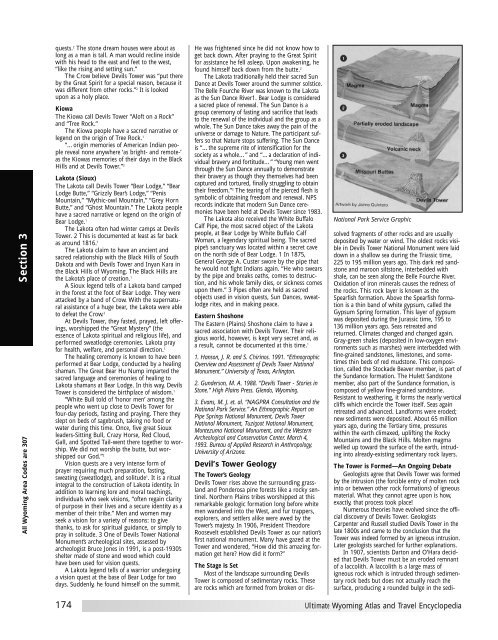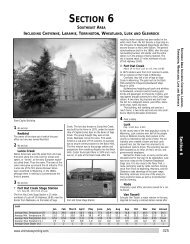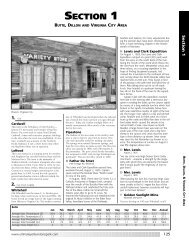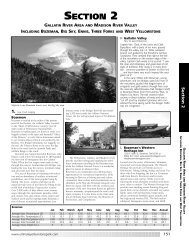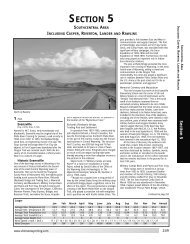SECTION 3 - New Times Media Corporation
SECTION 3 - New Times Media Corporation
SECTION 3 - New Times Media Corporation
Create successful ePaper yourself
Turn your PDF publications into a flip-book with our unique Google optimized e-Paper software.
Section 3<br />
All Wyoming Area Codes are 307<br />
quests. 2 The stone dream houses were about as<br />
long as a man is tall. A man would recline inside<br />
with his head to the east and feet to the west,<br />
“like the rising and setting sun.”<br />
The Crow believe Devils Tower was “put there<br />
by the Great Spirit for a special reason, because it<br />
was different from other rocks.” 2 It is looked<br />
upon as a holy place.<br />
Kiowa<br />
The Kiowa call Devils Tower “Aloft on a Rock”<br />
and “Tree Rock.”<br />
The Kiowa people have a sacred narrative or<br />
legend on the origin of Tree Rock. 1<br />
“…origin memories of American Indian people<br />
reveal none anywhere ‘as bright- and remote-’<br />
as the Kiowas memories of their days in the Black<br />
Hills and at Devils Tower.” 2<br />
Lakota (Sioux)<br />
The Lakota call Devils Tower “Bear Lodge,” “Bear<br />
Lodge Butte,” “Grizzly Bear’s Lodge,” “Penis<br />
Mountain,” “Mythic-owl Mountain,” “Grey Horn<br />
Butte,” and “Ghost Mountain.” The Lakota people<br />
have a sacred narrative or legend on the origin of<br />
Bear Lodge. 1<br />
The Lakota often had winter camps at Devils<br />
Tower. 2 This is documented at least as far back<br />
as around 1816. 1<br />
The Lakota claim to have an ancient and<br />
sacred relationship with the Black Hills of South<br />
Dakota and with Devils Tower and Inyan Kara in<br />
the Black Hills of Wyoming. The Black Hills are<br />
the Lakota’s place of creation. 1<br />
A Sioux legend tells of a Lakota band camped<br />
in the forest at the foot of Bear Lodge. They were<br />
attacked by a band of Crow. With the supernatural<br />
assistance of a huge bear, the Lakota were able<br />
to defeat the Crow. 2<br />
At Devils Tower, they fasted, prayed, left offerings,<br />
worshipped the “Great Mystery” (the<br />
essence of Lakota spiritual and religious life), and<br />
performed sweatlodge ceremonies. Lakota pray<br />
for health, welfare, and personal direction. 1<br />
The healing ceremony is known to have been<br />
performed at Bear Lodge, conducted by a healing<br />
shaman. The Great Bear Hu Nump imparted the<br />
sacred language and ceremonies of healing to<br />
Lakota shamans at Bear Lodge. In this way, Devils<br />
Tower is considered the birthplace of wisdom. 1<br />
“White Bull told of ‘honor men’ among the<br />
people who went up close to Devils Tower for<br />
four-day periods, fasting and praying. There they<br />
slept on beds of sagebrush, taking no food or<br />
water during this time. Once, five great Sioux<br />
leaders-Sitting Bull, Crazy Horse, Red Cloud,<br />
Gall, and Spotted Tail-went there together to worship.<br />
We did not worship the butte, but worshipped<br />
our God.” 2<br />
Vision quests are a very intense form of<br />
prayer requiring much preparation, fasting,<br />
sweating (sweatlodge), and solitude 1 . It is a ritual<br />
integral to the construction of Lakota identity. In<br />
addition to learning lore and moral teachings,<br />
individuals who seek visions, “often regain clarity<br />
of purpose in their lives and a secure identity as a<br />
member of their tribe.” Men and women may<br />
seek a vision for a variety of reasons: to give<br />
thanks, to ask for spiritual guidance, or simply to<br />
pray in solitude. 3 One of Devils Tower National<br />
Monument’s archeological sites, assessed by<br />
archeologist Bruce Jones in 1991, is a post-1930’s<br />
shelter made of stone and wood which could<br />
have been used for vision quests.<br />
A Lakota legend tells of a warrior undergoing<br />
a vision quest at the base of Bear Lodge for two<br />
days. Suddenly, he found himself on the summit.<br />
174<br />
He was frightened since he did not know how to<br />
get back down. After praying to the Great Spirit<br />
for assistance he fell asleep. Upon awakening, he<br />
found himself back down from the butte. 2<br />
The Lakota traditionally held their sacred Sun<br />
Dance at Devils Tower around the summer solstice.<br />
The Belle Fourche River was known to the Lakota<br />
as the Sun Dance River1. Bear Lodge is considered<br />
a sacred place of renewal. The Sun Dance is a<br />
group ceremony of fasting and sacrifice that leads<br />
to the renewal of the individual and the group as a<br />
whole. The Sun Dance takes away the pain of the<br />
universe or damage to Nature. The participant suffers<br />
so that Nature stops suffering. The Sun Dance<br />
is “…the supreme rite of intensification for the<br />
society as a whole…” and “…a declaration of individual<br />
bravery and fortitude…” “Young men went<br />
through the Sun Dance annually to demonstrate<br />
their bravery as though they themselves had been<br />
captured and tortured, finally struggling to obtain<br />
their freedom.” 3 The tearing of the pierced flesh is<br />
symbolic of obtaining freedom and renewal. NPS<br />
records indicate that modern Sun Dance ceremonies<br />
have been held at Devils Tower since 1983.<br />
The Lakota also received the White Buffalo<br />
Calf Pipe, the most sacred object of the Lakota<br />
people, at Bear Lodge by White Buffalo Calf<br />
Woman, a legendary spiritual being. The sacred<br />
pipe’s sanctuary was located within a secret cave<br />
on the north side of Bear Lodge. 1 In 1875,<br />
General George A. Custer swore by the pipe that<br />
he would not fight Indians again. “He who swears<br />
by the pipe and breaks oaths, comes to destruction,<br />
and his whole family dies, or sickness comes<br />
upon them.” 3 Pipes often are held as sacred<br />
objects used in vision quests, Sun Dances, sweatlodge<br />
rites, and in making peace.<br />
Eastern Shoshone<br />
The Eastern (Plains) Shoshone claim to have a<br />
sacred association with Devils Tower. Their religious<br />
world, however, is kept very secret and, as<br />
a result, cannot be documented at this time. 1<br />
1. Hanson, J. R. and S. Chirinos. 1991. “Ethnographic<br />
Overview and Assessment of Devils Tower National<br />
Monument.” University of Texas, Arlington.<br />
2. Gunderson, M. A. 1988. “Devils Tower - Stories in<br />
Stone.” High Plains Press. Glendo, Wyoming.<br />
3. Evans, M. J. et. al. “NAGPRA Consultation and the<br />
National Park Service.” An Ethnographic Report on<br />
Pipe Springs National Monument, Devils Tower<br />
National Monument, Tuzigoot National Monument,<br />
Montezuma National Monument, and the Western<br />
Archeological and Conservation Center. March 4,<br />
1993. Bureau of Applied Research in Anthropology,<br />
University of Arizona.<br />
Devil’s Tower Geology<br />
The Tower’s Geology<br />
Devils Tower rises above the surrounding grassland<br />
and Ponderosa pine forests like a rocky sentinel.<br />
Northern Plains tribes worshipped at this<br />
remarkable geologic formation long before white<br />
men wandered into the West, and fur trappers,<br />
explorers, and settlers alike were awed by the<br />
Tower’s majesty. In 1906, President Theodore<br />
Roosevelt established Devils Tower as our nation’s<br />
first national monument. Many have gazed at the<br />
Tower and wondered, “How did this amazing formation<br />
get here? How did it form?”<br />
The Stage is Set<br />
Most of the landscape surrounding Devils<br />
Tower is composed of sedimentary rocks. These<br />
are rocks which are formed from broken or dis-<br />
National Park Service Graphic<br />
solved fragments of other rocks and are usually<br />
deposited by water or wind. The oldest rocks visible<br />
in Devils Tower National Monument were laid<br />
down in a shallow sea during the Triassic time,<br />
225 to 195 million years ago. This dark red sandstone<br />
and maroon siltstone, interbedded with<br />
shale, can be seen along the Belle Fourche River.<br />
Oxidation of iron minerals causes the redness of<br />
the rocks. This rock layer is known as the<br />
Spearfish formation. Above the Spearfish formation<br />
is a thin band of white gypsum, called the<br />
Gypsum Spring formation. This layer of gypsum<br />
was deposited during the Jurassic time, 195 to<br />
136 million years ago. Seas retreated and<br />
returned. Climates changed and changed again.<br />
Gray-green shales (deposited in low-oxygen environments<br />
such as marshes) were interbedded with<br />
fine-grained sandstones, limestones, and sometimes<br />
thin beds of red mudstone. This composition,<br />
called the Stockade Beaver member, is part of<br />
the Sundance formation. The Hulett Sandstone<br />
member, also part of the Sundance formation, is<br />
composed of yellow fine-grained sandstone.<br />
Resistant to weathering, it forms the nearly vertical<br />
cliffs which encircle the Tower itself. Seas again<br />
retreated and advanced. Landforms were eroded;<br />
new sediments were deposited. About 65 million<br />
years ago, during the Tertiary time, pressures<br />
within the earth climaxed, uplifting the Rocky<br />
Mountains and the Black Hills. Molten magma<br />
welled up toward the surface of the earth, intruding<br />
into already-existing sedimentary rock layers.<br />
The Tower is Formed—An Ongoing Debate<br />
Geologists agree that Devils Tower was formed<br />
by the intrusion (the forcible entry of molten rock<br />
into or between other rock formations) of igneous<br />
material. What they cannot agree upon is how,<br />
exactly, that process took place!<br />
Numerous theories have evolved since the official<br />
discovery of Devils Tower. Geologists<br />
Carpenter and Russell studied Devils Tower in the<br />
late 1800s and came to the conclusion that the<br />
Tower was indeed formed by an igneous intrusion.<br />
Later geologists searched for further explanations.<br />
In 1907, scientists Darton and O’Hara decided<br />
that Devils Tower must be an eroded remnant<br />
of a laccolith. A laccolith is a large mass of<br />
igneous rock which is intruded through sedimentary<br />
rock beds but does not actually reach the<br />
surface, producing a rounded bulge in the sedi-<br />
Ultimate Wyoming Atlas and Travel Encyclopedia


